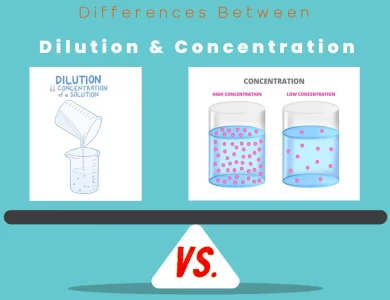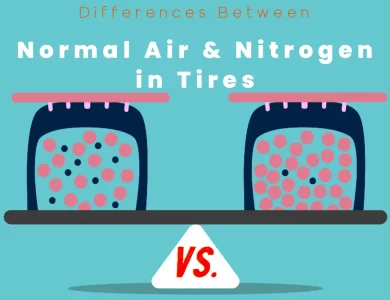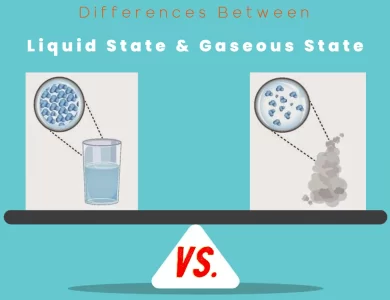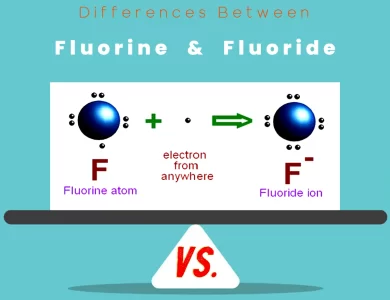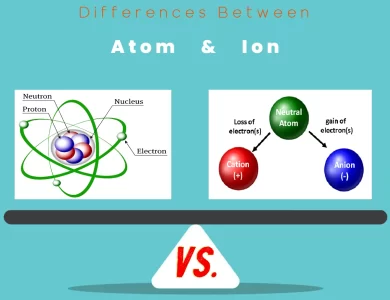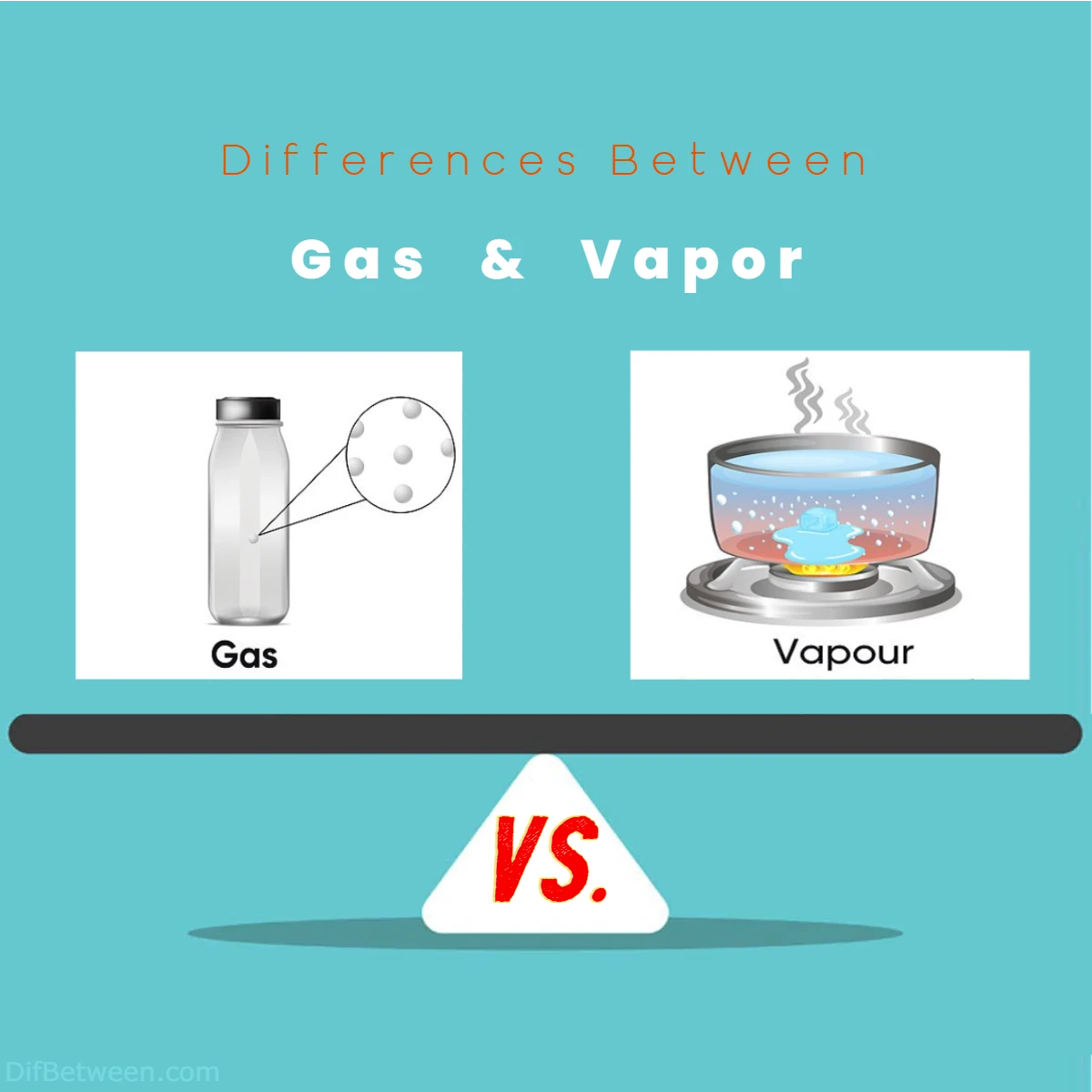
| Aspect | Gas | Vapor |
|---|---|---|
| Molecular Motion | Molecules move rapidly and freely in all directions. | Molecules move freely but are often closer to equilibrium. |
| Density | Generally low density due to widely spaced molecules. | Density can vary depending on temperature and substance. |
| Visibility | Usually invisible to the naked eye. | Visible when condensed into mist or droplets. |
| Formation | Exists at high temperatures or low pressures. | Forms when a substance evaporates or reaches boiling point. |
| Equilibrium | Not inherently associated with equilibrium. | Often reaches equilibrium with its liquid or solid phase. |
| Energy Absorption/Release | Absorbs energy during ionization or excitation. | Absorbs energy during vaporization and releases during condensation. |
| Examples | Oxygen, nitrogen, hydrogen in the atmosphere. | Steam from boiling water, mist above a hot beverage. |
| Intermolecular Forces | Experience weak Van der Waals forces. | Can involve hydrogen bonding and other stronger forces. |
| Phase Transition | Transitions to liquid or solid upon cooling. | Transitions from liquid or solid to gas upon heating. |
| Mixing and Homogeneity | Mixes uniformly with other gases. | Diffusion can be influenced by concentration and factors. |
| Phase Diagrams | Wide range of temperature for existence. | Vaporization is a crucial point in the phase diagram. |
| Application | Atmospheric composition, industrial processes. | Water cycle, culinary techniques, power generation. |
Picture a bustling dance floor, where gas molecules shimmy and sway, carefree in their rapid motion. Gas is the life of the party, occupying vast spaces and mingling with an undeniable energy. Now, let’s introduce vapor – the subtle yet mesmerizing cousin of the gaseous world. It’s a tale of equilibrium and transformation, where molecules embark on a graceful waltz between liquid and gaseous states. With every rise of steam from your cup of tea or each puff of cloud painting the sky, the dichotomy between these two entities comes alive.
Differences Between Gas and Vapor
The main differences between gas and vapor lie in their molecular behavior and origins. Gas molecules are in constant, rapid motion, while vapor molecules are more focused on achieving equilibrium with their parent liquid or solid phase. Gases have low densities and expand to fill their containers, whereas vapors can vary in density and often become visible when condensed into mist or droplets. Gases, like oxygen and nitrogen, constitute Earth’s atmosphere, while vapor plays a pivotal role in the water cycle and culinary techniques. In essence, understanding these disparities illuminates the intricate dance between these two gaseous entities, enriching our comprehension of the world of matter.
Defining Gas and Vapor
Gas: A Dance of Molecules
Imagine a lively crowd at a concert, each individual swaying and bouncing independently. Similarly, gas is a state of matter where molecules are in constant, rapid motion. These molecules are free to move around in any direction, colliding and rebounding off each other and the container walls like partygoers mingling on a dance floor. The kinetic energy of these molecules keeps them from sticking together, maintaining a significant amount of space between them.
Vapor: The Ephemeral Emanation
Vapor, on the other hand, is a bit more elusive. It’s essentially the gaseous phase of a substance that is typically found in a different state at room temperature. Imagine a pot of water simmering on a stove. As the water absorbs heat energy, it transitions into steam – a collection of water vapor molecules. In essence, vapor is like the coy cousin of gas. It’s not generated solely by raising the temperature; it can also form when a substance evaporates into the air, even at lower temperatures.
The Diverse States of Existence
Gas: No Bounds to Shape
Gas has a remarkable characteristic – it expands to fill the space available to it. This is evident when you release a whiff of your favorite perfume into the air. The scent diffuses rapidly, evenly distributing itself across the room. Gases have no defined shape or volume; they take on the shape of their container. So, whether it’s a tiny test tube or a massive hot air balloon, the gas inside will adapt accordingly.
Vapor: The Intricacies of Equilibrium
Vapor, while displaying similar properties of gases, has a specific equilibrium to it. Going back to our simmering pot of water, as the water molecules escape into the air as vapor, an equilibrium is established. This means that while water molecules continue to evaporate from the surface, an equal number of water molecules condense back into the liquid state. This delicate balance highlights vapor’s connection with its parent liquid or solid phase.
The Temperature Tango: Boiling Points and More
Gas: A Chilled Affair
Gases are quite unapologetic when it comes to temperature. Lower the temperature, and they’ll condense into a liquid or solid form. This process is aptly named condensation. For instance, consider a can of soda on a hot day. The moisture that forms on the exterior is a result of the water vapor in the air coming into contact with the cold surface of the can. As the vapor loses heat energy, it transitions back into its liquid state.
Vapor: Hot Pursuit
Vapor, while also subject to temperature changes, has a special affinity for dancing around its boiling point. Every substance has a specific temperature at which it transitions from its liquid state to a vapor state. This temperature is known as the boiling point. When you heat a liquid, its vapor pressure increases until it matches the pressure exerted on it by its surroundings. At this point, bubbles of vapor form within the liquid, and voila – you’re witnessing boiling in action.
Molecular Attractions: Van der Waals and Hydrogen Bonding
Gas: The Independent Nomads
Gas molecules are like social butterflies – they mingle but aren’t particularly attached to each other. They experience weak intermolecular forces known as Van der Waals forces. These are temporary attractions that occur due to momentary fluctuations in electron distribution around molecules. These forces are rather feeble, allowing gas particles to move about freely.
Vapor: Bonds That Matter
Vapor takes on a more intimate approach due to its association with liquids and solids. Hydrogen bonding comes into play here. This stronger type of intermolecular force forms when hydrogen atoms in a molecule are attracted to highly electronegative atoms in neighboring molecules. Think of it as a molecular hug, binding the vapor molecules a bit closer together than the independent gas particles.
Real-Life Applications
Gas: Beyond the Atmosphere
Gases are everywhere, quite literally. The Earth’s atmosphere is primarily composed of nitrogen and oxygen gases, with a sprinkling of other gases like carbon dioxide and argon. This mixture of gases creates the air we breathe, and its composition plays a crucial role in supporting life as we know it. Gases are also found in various industrial processes. For instance, oxygen gas is used in medical settings for respiratory support, while hydrogen gas finds its place in fuel cells for generating clean electricity.
Vapor: A Culinary Connection
Vapor is a kitchen magician. The process of steaming vegetables is a prime example. As you apply heat to water, it transitions into steam, which envelops the veggies. This gentle method of cooking ensures that the food retains its nutrients and flavors without being submerged in water. Vapor is also a vital player in the realm of climate – water vapor in the atmosphere influences weather patterns and contributes to the formation of clouds and precipitation.
Density and Molecular Arrangement
Gas: A Sparse Gathering
Gases are known for their low density. Since gas molecules are in constant motion and are relatively far apart from each other, they have a low mass per unit volume. This results in gases having low densities compared to liquids and solids. For instance, consider the air around us. Despite the vast volume it occupies, the actual mass of the gases in the atmosphere is relatively small.
Vapor: A Weighty Mystery
Vapor, while still gaseous in nature, can have varying densities depending on the substance it originates from. The density of vapor is influenced by factors such as temperature and pressure. In some cases, vapor can be denser than the surrounding air, leading it to settle near the ground. A familiar example is the mist that forms above a hot beverage – the vapor from the hot liquid condenses as it meets the cooler air, creating a visible cloud.
Visibility and Observability
Gas: Seen and Unseen
Gases are generally invisible to the naked eye. The molecules are spaced far apart and do not typically scatter visible light, which is why we don’t notice them filling up a room. However, some gases exhibit color when they are ionized or interact with other substances. Neon lights, for instance, glow with vibrant colors due to the ionization of the neon gas inside.
Vapor: The Visible Ghost
Vapor, in its misty and condensed form, is visible. When vapor condenses into tiny water droplets or ice crystals, it scatters light in various directions, making it observable. Clouds, for example, are visible masses of water vapor suspended in the atmosphere. Similarly, the steam rising from a boiling kettle is vapor that has condensed into tiny droplets upon meeting the cooler air.
Energy Absorption and Release
Gas: Temperature Dictates State
For gases to transform into a liquid or solid state, they must release energy. This energy is released in the form of heat when gas molecules slow down and come closer together during the condensation process. This is why condensation of gases is an exothermic process, meaning it releases heat energy.
Vapor: Energy in Transition
Vapor, on the other hand, absorbs energy during its formation. When a substance transitions from a liquid or solid state to vapor, it requires an input of heat energy. This energy enables the molecules to overcome the intermolecular forces that hold them together in the denser phases. The energy absorbed during vaporization is subsequently released when the vapor condenses back into its liquid or solid state.
Examples in Nature and Industry
Gas: The Breath of Life
Gases play an essential role in various natural processes. For instance, photosynthesis, the process by which plants convert carbon dioxide and sunlight into energy, involves the exchange of gases. Plants take in carbon dioxide gas from the atmosphere and release oxygen gas, which is vital for the survival of many living organisms, including humans. In industries, gases are used for a range of purposes, from welding (where acetylene gas is utilized) to carbonation of beverages (using carbon dioxide gas).
Vapor: The Dance of Clouds
Vapor’s presence shapes our environment in captivating ways. The water cycle, driven by the evaporation and condensation of water, involves the transformation of liquid water into water vapor and its subsequent return to Earth as precipitation. Clouds, formed from water vapor condensing in the atmosphere, create a picturesque canvas in the sky. In the realm of industry, vapor plays a role in power generation. In steam power plants, water is heated to produce steam, which drives turbines to generate electricity.
Gas: Wide Temperature Range
For most substances, gases can exist at a wide range of temperatures. They transition from the solid to liquid to gas phases as the temperature increases. The phase transition from solid to liquid is known as melting, and the transition from liquid to gas is vaporization.
Vapor: A Point of Transformation
Vaporization, in particular, holds a key role in the phase diagram. The phase diagram is a graphical representation of the various phases a substance can exist in under different conditions of temperature and pressure. The point at which the solid, liquid, and vapor phases coexist in equilibrium is known as the triple point. Beyond this point, as temperature and pressure change, a substance transitions directly between the solid and vapor phases in a process called sublimation.
Mixing and Homogeneity
Gas: Uniformly Unpredictable
Gases mix freely and uniformly. When you release a different gas into an area, it rapidly spreads and mingles with the existing gases. This homogenous mixing occurs due to the high kinetic energy and random motion of gas molecules.
Vapor: Balancing Act
Vapors exhibit a form of mixing known as diffusion. However, vapor diffusion can be influenced by the concentration of the vapor and the presence of other gases. For instance, when a pleasant aroma fills a room, it’s due to the diffusion of vaporized scent molecules. The speed and extent of diffusion depend on factors such as temperature, pressure, and the molecular properties of the substances involved.
FAQs
The key distinction lies in their origins and behavior. Gas consists of molecules in rapid motion, filling the space and taking the shape of their container. Vapor, however, is the gaseous phase of a substance that is typically in a different state at room temperature, often forming when a substance evaporates or reaches its boiling point.
Certainly! Equilibrium is more prevalent in vapors. When a substance transforms into vapor, an equilibrium is established between the vapor and its parent liquid or solid phase. This means that while molecules continue to transition from the liquid or solid state to vapor, an equal number of vapor molecules condense back into the liquid or solid state, maintaining a balance.
Gases are generally invisible to the naked eye due to the widely spaced molecules that don’t scatter visible light. On the other hand, vapor becomes visible when it condenses into mist or tiny droplets. Clouds, for instance, are formed from water vapor condensing in the atmosphere, creating visible masses in the sky.
For gases to transform into liquids or solids, they release energy during the process of condensation. In contrast, vaporization requires an input of heat energy to overcome the intermolecular forces holding molecules together in the liquid or solid phase. The energy absorbed during vaporization is subsequently released when vapor condenses back into a liquid or solid state.
Gases form the composition of our atmosphere, with oxygen and nitrogen being essential components. Vapors are instrumental in processes like the water cycle, where water evaporates from bodies of water, forms clouds, and eventually falls as precipitation. In cooking, vapor is harnessed to steam vegetables gently, preserving nutrients and flavors.
Gases mix uniformly with other gases due to their rapid motion and random collisions. Vapor, while also undergoing a process of diffusion, can be influenced by factors like concentration and molecular properties. For instance, the pleasant aroma spreading through a room is due to the diffusion of vaporized scent molecules.
Gases typically have a wide range of temperatures over which they exist. Vaporization holds a significant role in phase diagrams, as it marks the transition from the liquid to the gas phase. The phase diagram showcases the conditions at which a substance exists in different phases, highlighting the unique points of transformation.
Certainly! Gases like oxygen and carbon dioxide in the atmosphere are crucial for supporting life. In contrast, vapor is evident in the water cycle, where water evaporates from oceans, forms clouds, and falls as rain. It’s also used in culinary techniques, like steaming vegetables, and plays a role in power generation in steam power plants.
Gases experience weak Van der Waals forces due to their widely spaced molecules. Vapors, on the other hand, often involve stronger intermolecular forces like hydrogen bonding. These forces bind vapor molecules closer together, especially when vapor is associated with its liquid or solid phase.
By grasping the nuances between gas and vapor, we gain insights into the dynamic nature of matter. From the uninhibited motion of gas molecules to the equilibrium-driven behavior of vapors, these distinctions enhance our comprehension of various natural processes, industrial applications, and even everyday phenomena like the formation of clouds and the aroma of a freshly brewed cup of tea.
Read More:
Contents
- Differences Between Gas and Vapor
- Defining Gas and Vapor
- The Diverse States of Existence
- The Temperature Tango: Boiling Points and More
- Molecular Attractions: Van der Waals and Hydrogen Bonding
- Real-Life Applications
- Density and Molecular Arrangement
- Visibility and Observability
- Energy Absorption and Release
- Examples in Nature and Industry
- Phase Diagrams: Navigating Transitions
- Mixing and Homogeneity
- FAQs
